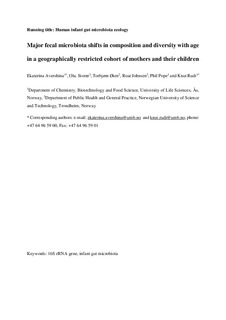Major faecal microbiota shifts in composition and diversity with age in a geographically restricted cohort of mothers and their children
Journal article, Peer reviewed
Accepted version
Permanent lenke
http://hdl.handle.net/11250/2458295Utgivelsesdato
2014Metadata
Vis full innførselSamlinger
Sammendrag
Despite the importance, the diversity of the human infant gut microbiota still remains poorly characterized at the regional scale. Here, we investigated the faecal microbiota diversity in a large 16S rRNA gene data set from a healthy cohort of 86 mothers and their children from the Trondheim region in Norway. Samples were collected from mothers during early and late pregnancy, as well as from their children at 3 days, 10 days, 4 months, 1 year and 2 years of age. Using a combination of Sanger sequencing of amplicon mixtures (without cloning), real-time quantitative PCR and deep pyrosequencing, we observed a clear age-related colonization pattern in children that was surprisingly evident between 3- and 10-day samples. In contrast, we did not observe any shifts in microbial composition during pregnancy. We found that alpha-diversity was highest at 2 years and lowest at 4 months, whereas beta-diversity estimates indicated highest interindividual variation in newborns. Variation significantly decreased by the age of 10 days and was observed to be convergent over time; however, there were still major differences between 2 years and adults whom exhibited the lowest interindividual diversity. Taken together, the major age-affiliated population shift within gut microbiota suggests that there are important mechanisms for transmission and persistence of gut bacteria that remain unknown.
